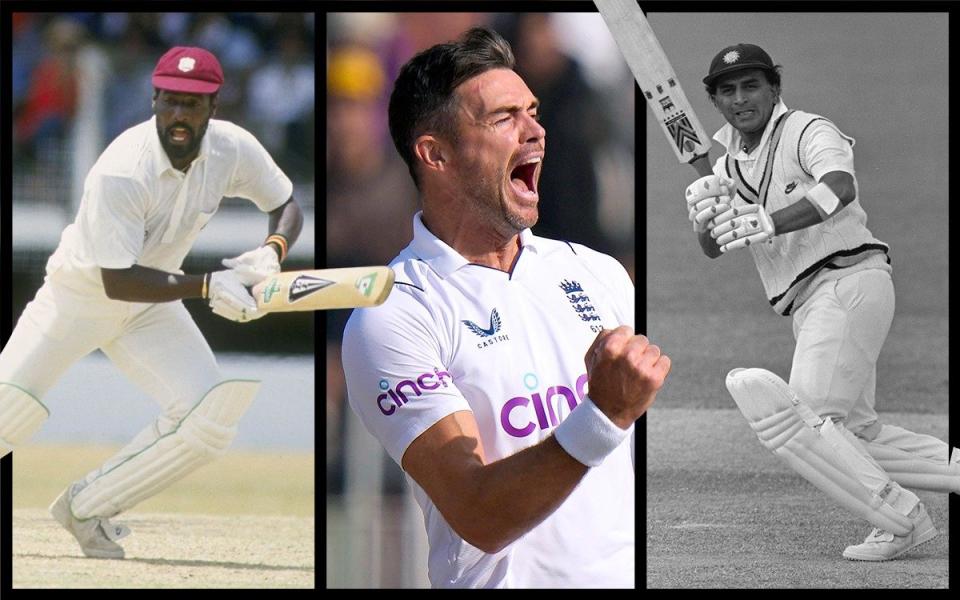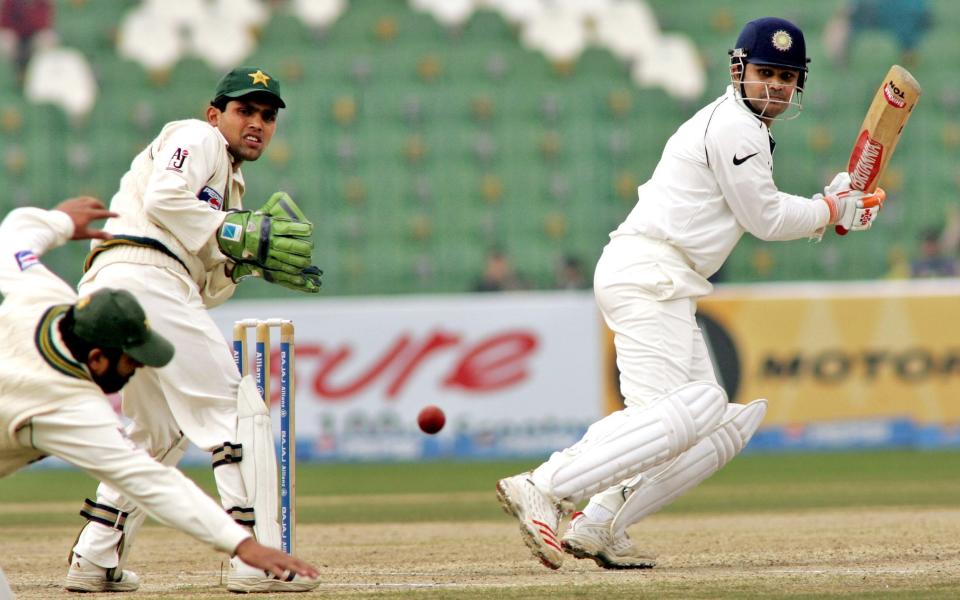All-time World Test XI, as voted by Telegraph readers

After a week of voting, polls have closed in our bid to determine which players should make up the greatest cricket team in history. According to Telegraph readers, the XI is as follows.
Jack Hobbs (England)
Sunil Gavaskar (India)
Sir Donald Bradman (Australia, capt)
Sir Viv Richards (West Indies)
Sachin Tendulkar (India)
Sir Garfield Sobers (West Indies)
Adam Gilchrist (Australia, wkt)
Shane Warne (Australia)
Malcolm Marshall (West Indies)
James Anderson (England)
Sir Curtly Ambrose (West Indies)
The polls for the allrounder (Sobers), wicket-keeper (Gilchrist) and spinner (Warne) were not even close. In the selection of opening batsmen, Alastair Cook and Len Hutton narrowly missed out. Brian Lara very nearly beat Sachin Tendulkar to a place in the middle order and in the selection of the three seamers. Glenn McGrath missed out to Curtly Ambrose by a single vote.
Scyld Berry's all-time World Test XI
My all-time World Test XI would be as follows:
Graeme Smith (South Africa)
Virender Sehwag (India)
Sir Donald Bradman (Australia, capt)
Sir Viv Richards (West Indies)
Sachin Tendulkar (India)
Sir Garfield Sobers (West Indies)
Adam Gilchrist (Australia, wkt)
Shane Warne (Australia)
Malcolm Marshall (West Indies)
Mitchell Johnson (Australia)
Sir Curtly Ambrose (West Indies)
Back in the days when there were such things as envelopes, I always had Sir Jack Hobbs and Sunil Gavaskar written on the back, as the opening batsmen for a World Test XI. Never has there been such a complete batsman as Hobbs, because nobody has ever batted on such a vast range of pitches, from mud-heaps to belters, let alone scored 61,000 first-class runs on them; and Gavaskar was the embodiment of orthodox technique.
Now, however, it looks as though Test cricket will always be played on dry and pretty batting-friendly pitches; the sport has moved on, if not evolved. Strategy can therefore be based on a more attacking approach. In the past it was bowlers who attacked, now it is batsmen who pressurise bowlers.
Test cricket’s change of approach - and this is all a matter of opinion - demands a different Indian opening batsman, Virender Sehwag.
We did not see the best of him in England but that should not rule out what he accomplished elsewhere: huge hundreds, made at a faster rate than any opener has achieved, with the majesty of a souped-up Majid Khan.
I remember a press conference in South Africa when the two captains, Andrew Strauss and Graeme Smith, took sneak peaks at the television as Sehwag raised the bar to a new level, which no opener has yet equalled, even in this age of so-called Bazball.

To complement Sehwag, I would choose a left-handed opener of more defensive character. There have been few uglier batsmen; but there will be aesthetic pleasures to come in the World XI batting order. If Sehwag gets out early, and Don Bradman starts playing a few shots, I would want someone tenacious at the other end: the aforementioned Smith.
He broke three England captains (Nasser Hussain, Michael Vaughan and Strauss) and might do the same to the opposing captain in this hypothetical Test. And Smith remains the most successful Test captain of all time in terms of victories, 53, so if the Bradman in this team were the young man who was so busy with commercial interests, Smith could captain as well.
You would imagine that Sir Donald would insist on batting at three. If so, and he were to be dismissed cheaply, and the opposition were considerably buoyed, there is one man who could walk out and wordlessly - because they might not speak English or any earthly language - tell them who was boss: Sir Viv Richards.
At number five it is a close thing between Brian Lara and Sachin Tendulkar; but no need for another left-hander with Sir Garfield Sobers at six and Adam Gilchrist at seven, especially one similar in style to Sobers.
I wish this World XI could include the most beautiful of post-war batsmen, and the most handsome of post-war batsmen, but I will settle for Sir Frank Worrell and Martin Crowe being the batting coaches.
We must not forget our fielding specialists when selecting the batsmen. You do not want to pick great fast bowlers without any decent slips to back them up. One more reason to opt for Smith, to go first slip, although Sir Alastair Cook would do a sound job there; and Richards at second slip, and Shane Warne at third, while Sobers was superb close-in legside.
If I were Sir Donald Bradman (I wish) and captaining this team, I would base my bowling strategy on pace. And while there have been better attacks than Australia’s in 2013-14, I personally think that no bowler has ever been more threatening - to life, limb and wicket - than Mitchell Johnson was in that series.
I would base my strategy on using Johnson in short bursts of about four overs. Some will prefer Wasim Akram of Pakistan as the left-arm fast bowler, and he was a master of reverse-swing, but Johnson too could reverse it, and whether from over or round the wicket he could fire in the most ferocious bouncers.
Johnson at his peak gives his captain the maximum of penetration; Curtly Ambrose of control. Even in the white-ball era nobody took him apart. Glenn McGrath very occasionally had a bad day, but Ambrose was always in control.
We are all assuming that the opponents of this World XI have two feet. Suppose they are extra-terrestrial beings with four or six feet: they will be able to run down the pitch and pad Warne away. But nobody is running down the pitch to King Curt.
Malcolm Marshall, as the complete fast bowler, can offer his captain penetration AND control. Any of these three pace bowlers could take the new ball, as could Sobers, who would probably swing it more than anyone. Blessed with his unique all-round abilities, Sobers would also act as the second spinner, whether as a left-arm orthodox or wrist-spinner.
Having Adam Gilchrist as the wicketkeeper/batsman ensures that he will already be familiar with Warne, and accustomed to taking wrist-spin, so that he should be able to read Sobers too. If Derek Underwood were chosen as the specialist spinner, Alan Knott would have been the logical choice; so too MS Dhoni, or Rishabh Pant in the near future, if Ravi Ashwin were the spinner.
As twelfth man, or as a concussion substitute were the opposition to launch something unfamiliar at the World XI: Jacques Kallis.
Four Australians, four West Indians, three knights, two Indians, one South African and no England cricketer. All right, accuse me of many things, but not national bias.
In any event, if there is no overlap between the World XI and the England XI selected earlier this year, we can savour the mouthwatering prospect of the two teams playing each other in the ultimate Test...in England?
Fun to watch? Or even better to umpire and to listen to what Fred Trueman says to The Don?

 Yahoo Sport
Yahoo Sport 




































































